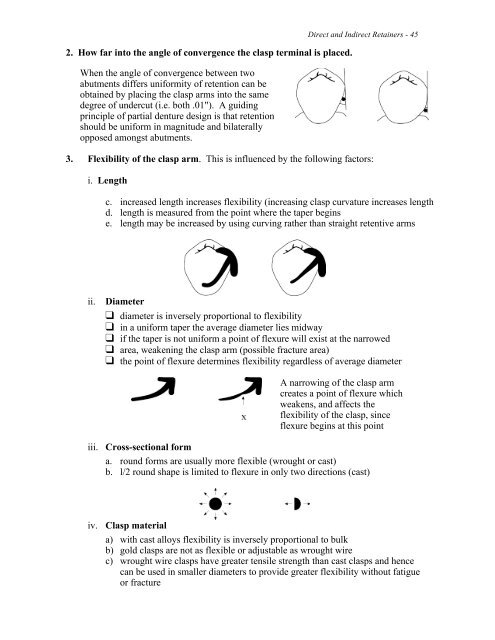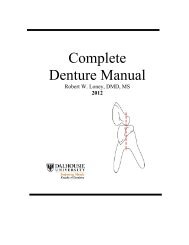RPD Manual 11 - Removable Prosthodontics - Dalhousie University
RPD Manual 11 - Removable Prosthodontics - Dalhousie University
RPD Manual 11 - Removable Prosthodontics - Dalhousie University
You also want an ePaper? Increase the reach of your titles
YUMPU automatically turns print PDFs into web optimized ePapers that Google loves.
2. How far into the angle of convergence the clasp terminal is placed.<br />
When the angle of convergence between two<br />
abutments differs uniformity of retention can be<br />
obtained by placing the clasp arms into the same<br />
degree of undercut (i.e. both .01"). A guiding<br />
principle of partial denture design is that retention<br />
should be uniform in magnitude and bilaterally<br />
opposed amongst abutments.<br />
Direct and Indirect Retainers - 45<br />
3. Flexibility of the clasp arm. This is influenced by the following factors:<br />
i. Length<br />
c. increased length increases flexibility (increasing clasp curvature increases length<br />
d. length is measured from the point where the taper begins<br />
e. length may be increased by using curving rather than straight retentive arms<br />
ii. Diameter<br />
" diameter is inversely proportional to flexibility<br />
" in a uniform taper the average diameter lies midway<br />
" if the taper is not uniform a point of flexure will exist at the narrowed<br />
" area, weakening the clasp arm (possible fracture area)<br />
" the point of flexure determines flexibility regardless of average diameter<br />
A narrowing of the clasp arm<br />
creates a point of flexure which<br />
weakens, and affects the<br />
flexibility of the clasp, since<br />
flexure begins at this point<br />
iii. Cross-sectional form<br />
a. round forms are usually more flexible (wrought or cast)<br />
b. l/2 round shape is limited to flexure in only two directions (cast)<br />
iv. Clasp material<br />
a) with cast alloys flexibility is inversely proportional to bulk<br />
b) gold clasps are not as flexible or adjustable as wrought wire<br />
c) wrought wire clasps have greater tensile strength than cast clasps and hence<br />
can be used in smaller diameters to provide greater flexibility without fatigue<br />
or fracture















